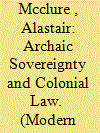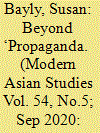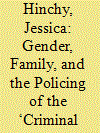|
|
|
Sort Order |
|
|
|
Items / Page
|
|
|
|
|
|
|
| Srl | Item |
| 1 |
ID:
174136


|
|
|
|
|
| Summary/Abstract |
The abdication of Prajadhipok, King of Siam, in 1935 marked the end of the reign of the country's last absolute ruler and brought a young prince, Ananda Mahidol, to the throne in his place. Over the next decade, Ananda would rule in absentia as he grew up in Switzerland, leaving the regime considerable latitude to consolidate its authority over the monarchy and royal affairs. This article looks at three aspects of this period: the abdication as triumph of the authority of the Constitution over that of the king; the succession to the throne of a branch of the royal family that would otherwise have been bypassed; and the extended regency, which sanctioned rather than resisted the strengthening of government control over the monarchy.
|
|
|
|
|
|
|
|
|
|
|
|
|
|
|
|
| 2 |
ID:
174138


|
|
|
|
|
| Summary/Abstract |
The judicial and summary punishment of whipping—absent from the Indian Penal Code (IPC) of 1860—was passed into law through Act No. VI of 1864. This legislation, tacked on as an appendage to the IPC, invested the judge with wider discretionary powers to administer violence across Indian society. In this case what emerged was an evolving attempt to enlarge the colonial state's capacity for quotidian violence, targeting certain bodies to reaffirm, manage, and police the social hierarchies upon which colonial sovereignty depended. In the context of a slow imperial movement away from the cast-iron distinctions that had been made between groups in the early nineteenth century—distinctions that had, among other things, supported a legally enforced system of slavery—new methods to mark the value of different bodies were created. The events of the 1850s, in particular the rebellion of 1857–1858, saw the re-emergence of the colonial idea that certain bodies could withstand violence, and that violence itself could be used to create economically productive colonial societies, in debates around penal law and punishment. This article will trace this history through formal legal restrictions and informal legal-cultural practices in relation to corporal punishment in colonial India. Over the course of the period under study, this legislation introduced into law what one official termed ‘the category of the “whippable”’.1 Charting the changing shape of this legal category along lines of race, gender, caste, class, and age, the article will argue that a logic of exceptionality, channelled here through the application of judicial violence, attempted to structure and manage Indian society in complicated ways.
|
|
|
|
|
|
|
|
|
|
|
|
|
|
|
|
| 3 |
ID:
174134


|
|
|
|
|
| Summary/Abstract |
This article forges connections between two vibrant areas of current research within and beyond Asian studies: visual anthropology and the anthropology of morality and ethics. Its focus is on achieving moral citizenship as represented in Vietnam's visually spectacular capital, Hanoi, and on images as active and morally compelling, not mere reflections of the challenges of late-socialist marketization. The case of Vietnam compares intriguingly with other contexts where visuality has been fruitfully explored, including India and post-socialist Eurasia. The question asked is how images, both personal and official, can work either to provide or deny the viewer a quality of moral agency which they feel to be their due. The answer is found in the intertwining of silence and speech in relation to images. This includes what is said and unsaid in regard to public iconography, including memorial statuary and state message posters. It is proposed that the visuality of the urban street space is a continuum involving significant interaction with the intimacies of home and family image use. The article also seeks to add to our methodological ideas about treating fieldwork photographs as a basis for interaction with interlocutors, hence as active research tools rather than mere adjuncts to observation and analysis.
|
|
|
|
|
|
|
|
|
|
|
|
|
|
|
|
| 4 |
ID:
174132


|
|
|
|
|
| Summary/Abstract |
This article examines the importance of the exchange of foreign correspondents between Japan and China from 1964, during a period of the Cold War when the two countries did not have official ties. Favourable political circumstances in the first half of the 1960s led to a brief window of opportunity for an improved relationship between China and Japan, during which this unique exchange took place. The article attempts to shed light on the significance of the exchange within the broader context of Chinese foreign policy and Sino-Japanese relations during the Cold War. Thereby it will clarify the importance of the 1960–1964 period for the longer rapprochement process that would come to fruition in 1972 with the establishment of diplomatic relations. The exchanges of 1964 were seen by participants as an important first step on the way towards official ties. For the Chinese the importance of a relationship with Japan in this period, and, by extension, the importance of the journalist exchange, is shown by the involvement of an unusually high number of journalists from both countries. This article argues that the Chinese leadership's desire for the journalist exchange was rooted in a craving for accurate knowledge about Japan, especially concerning specific political trends and economic developments. This enthusiasm was matched by pro-China politicians in Japan, who also felt that the journalists’ presence would enable the Chinese to base their Japan policy on a broader variety of sources, extending beyond information merely gathered through contacts in the Japanese left.
|
|
|
|
|
|
|
|
|
|
|
|
|
|
|
|
| 5 |
ID:
174137


|
|
|
|
|
| Summary/Abstract |
In the South Asian setting, the fields of gender history and family history are still predominantly concerned with relatively elite social groups. Few studies have examined issues of gender and the family in the history of Dalit, low-caste, and socially marginalized communities, especially those that were labelled ‘criminal tribes’ from the mid-nineteenth century on. This article explores the ways in which gender patterned criminalized communities’ experiences of everyday colonial governance under Part I of the 1871 Criminal Tribes Act (CTA) in the first two decades that it was enforced in northern India. In this early period, the colonial government did not closely regulate marriage practices, domestic arrangements, or the gendered organization of labour within communities categorized as ‘criminal tribes’. Nevertheless, notions of sexuality and gender underlay colonial knowledge of the ‘criminal tribes’, which emerged in dialogue with middle-class Indian gender and caste politics. Moreover, the family unit was the central target of the CTA surveillance and policing regime, which aimed to produce ‘industrious’ families. Officially endorsed forms of labour had complex implications for criminalized communities in the context of North Indian gender norms and strategies of social mobility. Gender power dynamics also shaped criminalized peoples’ interpersonal, embodied interactions with British and Indian colonial officials on an everyday basis. Meanwhile, different forms of leverage and evasion were open to men and women to cope with their criminalization and so the colonial state was experienced in highly gendered ways.
|
|
|
|
|
|
|
|
|
|
|
|
|
|
|
|
| 6 |
ID:
174135


|
|
|
|
|
| Summary/Abstract |
The administrative (Chakri) reforms in Siam which took place around the turn of the twentieth century are probably one of the most studied topics in the history of Thailand. This period is usually described as the time when the royal elite worked to create a Siamese nation-state under the guidance of the absolute monarchy. This transformation encompassed both territorial integration and administrative centralization. Here we offer a new perspective on this transformative period through an analysis of changing documentary and spatial practices in Siam from the mid-nineteenth to the early twentieth centuries, which were one of the most crucial, intrinsic dynamics of state formation. The emphasis is on the mundane practices of documentation—among other spatial-material practices and processes—that produce the effect that the state exists. We show how this new paper regime articulated a standardization of written official documents, the birth of the file as a technology to deal with the avalanche of documents circulating between sections of the burgeoning administration, and the spatial organization that created the office—fields where officials produced and stored documents according to specific regulations. We exemplify this new regime of documentary practices in Bangkok and beyond, with special reference to the paper and spatial works of the provincial gendarmerie.
|
|
|
|
|
|
|
|
|
|
|
|
|
|
|
|
| 7 |
ID:
174131


|
|
|
|
|
| Summary/Abstract |
By providing the first comprehensive account of the role of the British and Indian press in war propaganda, this article makes an intervention in the global history of the First World War. The positive propaganda early in the war, intertwined with a rhetoric of loyalism, contrasted with how the conservative British press affixed blame for military defeats in Mesopotamia upon the colonial regime's failure to effectively mobilize India's resources. Using a highly emotive and enduring trope of the ‘Mesopotamia muddle’, the Northcliffe press was successful in channelling a high degree of public scrutiny onto the campaign. The effectiveness of this criticism ensured that debates about the Mesopotamian debacle became a vehicle for registering criticism of structures of colonial rule and control in India. On the one hand, this critique hastened constitutional reforms and devolution in colonial India and, on the other, it led to demands that the inadequacy of India's contribution to the war be remedied by raising war loans. Both the colonial government and its nationalist critics were briefly and paradoxically united in opposing these demands. The coercive extraction of funds for the imperial war effort as well as the British press's vituperative criticism contributed to a post-war, anti-colonial political upsurge. The procedure of creating a colonial ‘scandal’ out of a military disaster required a specific politics for assessing the regulated flows of information, which proved to be highly effective in shaping both the enquiry that followed and the politics of interwar colonial South Asia.
|
|
|
|
|
|
|
|
|
|
|
|
|
|
|
|
| 8 |
ID:
174133


|
|
|
|
|
| Summary/Abstract |
Situations of internecine warfare have in common to question the transitivity of everyday life—that is, its capacity to be taken for granted, to flow without any need for explication. These wars within the familiar generate specific anxieties about where to look at and what to believe. Events, persons, places, or objects whose status seemed hitherto undeniable become less predictable, while their worth comes into question. As individuals’ ontological security is threatened, the need for new monitoring devices and authentication procedures arises. Drawing on the phenomenology of civil wars and the anthropology of fakes, this contribution proposes to explore one such crisis of evidence: the nexus of political, ethnic, and criminal violence raging in Karachi's inner-city area of Lyari. Through the lens of local journalism, it reflects upon the tactics of social navigation deployed by residents confronted with chronic uncertainty in all sectors of life. Janbaz, the Urdu newspaper examined here, provides an opportunity to move beyond functionalist readings of the press in conflict situations. While insisting upon the pleasure derived by Janbaz’s readers from the sensationalized rendering of Lyari's predicament, we argue that the newspaper is the site of a continuous series of ‘reality tests’ and the focal point of private and collective investigations, pooling knowledge in an increasingly undecipherable environment. More than through its information, it is through its shortcomings that Janbaz has helped to recreate social ties in a world plagued by discord and uncertainty.
|
|
|
|
|
|
|
|
|
|
|
|
|
|
|
|
|
|
|
|
|